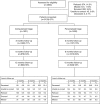Online screening for distress, the 6th vital sign, in newly diagnosed oncology outpatients: randomised controlled trial of computerised vs personalised triage
- PMID: 22828610
- PMCID: PMC3419958
- DOI: 10.1038/bjc.2012.309
Online screening for distress, the 6th vital sign, in newly diagnosed oncology outpatients: randomised controlled trial of computerised vs personalised triage
Abstract
Background: This randomised controlled trial examined the impact of screening for distress followed by two different triage methods on clinically relevant outcomes over a 12-month period.
Methods: Newly diagnosed patients attending a large tertiary cancer centre were randomised to one of the two conditions: (1) screening with computerised triage or (2) screening with personalised triage, both following standardised clinical triage algorithms. Patients completed the Distress Thermometer, Pain and Fatigue Thermometers, the Psychological Screen for Cancer (PSSCAN) Part C and questions on resource utilisation at baseline, 3, 6 and 12 months.
Results: In all, 3133 patients provided baseline data (67% of new patients); with 1709 (54.5%) retained at 12 months (15.4% deceased). Mixed effects models revealed that both groups experienced significant decreases in distress, anxiety, depression, pain and fatigue over time. People receiving personalised triage and people reporting higher symptom burden were more likely to access services, which was subsequently related to greater decreases in distress, anxiety and depression. Women may benefit more from personalised triage, whereas men may benefit more from a computerised triage model.
Conclusion: Screening for distress is a viable intervention that has the potential to decrease symptom burden up to 12 months post diagnosis. The best model of screening may be to incorporate personalised triage for patients indicating high levels of depression and anxiety while providing computerised triage for others.
Figures




Comment in
-
Benefits of screening cancer patients for distress still not demonstrated.Br J Cancer. 2013 Feb 19;108(3):736-7. doi: 10.1038/bjc.2013.16. Epub 2013 Jan 31. Br J Cancer. 2013. PMID: 23370207 Free PMC article. No abstract available.
-
Reply: benefits of screening cancer patients for distress still not demonstrated.Br J Cancer. 2013 Feb 19;108(3):738-9. doi: 10.1038/bjc.2013.17. Epub 2013 Jan 31. Br J Cancer. 2013. PMID: 23370210 Free PMC article. No abstract available.
-
Unresolved problems with distress screening.Br J Cancer. 2013 May 14;108(9):1922-3. doi: 10.1038/bjc.2013.137. Epub 2013 Apr 2. Br J Cancer. 2013. PMID: 23549039 Free PMC article. No abstract available.
-
Reply: comment on 'Online screening for distress, the 6th vital sign, in newly diagnosed oncology outpatients: randomised controlled trial of computerised vs personalised triage'--psychological distress in patients with cancer: is screening the effective solution?Br J Cancer. 2013 Jun 25;108(12):2631-2. doi: 10.1038/bjc.2013.287. Epub 2013 Jun 11. Br J Cancer. 2013. PMID: 23756860 Free PMC article. No abstract available.
-
Comment on 'psychological distress in patients with cancer: is screening the effective solution?'.Br J Cancer. 2013 Jun 25;108(12):2628-30. doi: 10.1038/bjc.2013.286. Epub 2013 Jun 11. Br J Cancer. 2013. PMID: 23756863 Free PMC article. No abstract available.
Similar articles
-
Reply: comment on 'Online screening for distress, the 6th vital sign, in newly diagnosed oncology outpatients: randomised controlled trial of computerised vs personalised triage'--psychological distress in patients with cancer: is screening the effective solution?Br J Cancer. 2013 Jun 25;108(12):2631-2. doi: 10.1038/bjc.2013.287. Epub 2013 Jun 11. Br J Cancer. 2013. PMID: 23756860 Free PMC article. No abstract available.
-
Screening for distress, the sixth vital sign, in lung cancer patients: effects on pain, fatigue, and common problems--secondary outcomes of a randomized controlled trial.Psychooncology. 2013 Aug;22(8):1880-8. doi: 10.1002/pon.3223. Epub 2012 Nov 12. Psychooncology. 2013. PMID: 23147718 Clinical Trial.
-
Screening for distress, the sixth vital sign: examining self-referral in people with cancer over a one-year period.Psychooncology. 2013 Feb;22(2):388-95. doi: 10.1002/pon.2102. Epub 2011 Dec 2. Psychooncology. 2013. PMID: 22135205
-
Telephone interventions for symptom management in adults with cancer.Cochrane Database Syst Rev. 2020 Jun 2;6(6):CD007568. doi: 10.1002/14651858.CD007568.pub2. Cochrane Database Syst Rev. 2020. PMID: 32483832 Free PMC article.
-
Best Practices in Oncology Distress Management: Beyond the Screen.Am Soc Clin Oncol Educ Book. 2018 May 23;38:813-821. doi: 10.1200/EDBK_201307. Am Soc Clin Oncol Educ Book. 2018. PMID: 30231391 Review.
Cited by
-
Usability and Preliminary Efficacy of an Adaptive Supportive Care System for Patients With Cancer: Pilot Randomized Controlled Trial.JMIR Cancer. 2024 Jul 10;10:e49703. doi: 10.2196/49703. JMIR Cancer. 2024. PMID: 38986134 Free PMC article.
-
Bringing PROMIS to practice: brief and precise symptom screening in ambulatory cancer care.Cancer. 2015 Mar 15;121(6):927-34. doi: 10.1002/cncr.29104. Epub 2014 Nov 6. Cancer. 2015. PMID: 25376427 Free PMC article.
-
Unresolved problems with distress screening.Br J Cancer. 2013 May 14;108(9):1922-3. doi: 10.1038/bjc.2013.137. Epub 2013 Apr 2. Br J Cancer. 2013. PMID: 23549039 Free PMC article. No abstract available.
-
Discriminatory power of a 25-item distress screening tool: a cross-sectional survey of 251 cancer survivors.Qual Life Res. 2014 Dec;23(10):2855-63. doi: 10.1007/s11136-014-0742-4. Epub 2014 Jun 26. Qual Life Res. 2014. PMID: 24966017
-
Distress levels in patients with oropharyngeal vs. non-oropharyngeal squamous cell carcinomas of the head and neck over 1 year after diagnosis: a retrospective cohort study.Support Care Cancer. 2017 Oct;25(10):3225-3233. doi: 10.1007/s00520-017-3733-5. Epub 2017 Jun 10. Support Care Cancer. 2017. PMID: 28600705
References
-
- Absolom K, Holch P, Pini S, Hill K, Liu A, Sharpe M (2011) The detection and management of emotional distress in cancer patients: the views of health-care professionals. Psychooncology 20(6): 601–608 - PubMed
-
- Accreditation Canada. Qmentum Program 2009 Standards: Cancer Care and Oncology Services. Version 2; 2008
-
- Akechi T, Okuyama T, Akizuki N, Azuma H, Sagawa R, Furukawa TA, Uchitomi Y (2006) Course of psychological distress and its predictors in advanced non-small cell lung cancer patients. Psychooncology 15: 463–473 - PubMed
-
- Andreu Y, Galdon MJ, Dura E, Martinez P, Perez S, Murgui S (2012) A longitudinal study of psychosocial distress in breast cancer: prevalence and risk factors. Psychol Health 27(1): 72–87 - PubMed
-
- Bidstrup PE, Johansen C, Mitchell AJ (2011) Screening for cancer-related distress: summary of evidence from tools to programmes. Acta Oncol 50: 194–204 - PubMed
Publication types
MeSH terms
LinkOut - more resources
Full Text Sources
Medical

